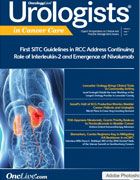First SITC Guidelines in RCC Address Continuing Role of Interleukin-2 and Emergence of Nivolumab
New guidelines involving the immunotherapies nivolumab (Opdivo) and interleukin-2 inhibitors have been issued by The Society for Immunotherapy of Cancer to help practicing clinicians manage patients with renal cell carcinoma.
Brian Rini, MD, professor of medicine at Cleveland Clinic’s Taussig Cancer Institute

Brian Rini, MD
New guidelines involving the immunotherapies nivolumab (Opdivo) and interleukin-2 (IL-2) have been issued by The Society for Immunotherapy of Cancer (SITC) to help practicing clinicians manage patients with renal cell carcinoma (RCC). The updated guidelines are needed because 10 agents have been approved for the treatment of patients with metastatic clear cell RCC, which accounts for 75% to 85% of all cases of metastatic RCC (mRCC) during the past 11 years. Meanwhile, new immunotherapies continue to enter the clinical arena.
For many years, immunotherapies, including interferon-alpha (IFN) and IL-2, have been used to successfully treat patients with mRCC. Newer therapies have been on the rise, however, such as vascular endothelial growth factor (VEGF) inhibitors, mammalian target of rapamycin (mTOR) inhibitors, and immune checkpoint inhibitors.
“Kidney cancer has always been considered to be a disease amenable to immunotherapy but until recently, there had never been any guidelines about the use of IL-2 or nivolumab and some of the emerging agents, so the guide- lines are designed to lay the groundwork as these agents get further developed in RCC,” said Brian Rini, MD, professor of medicine at Cleveland Clinic’s Taussig Cancer Institute and 1 chair of the 20 members of the task force assembled to create the guidelines. This consensus statement is the second publication to come out of SITC’s Cancer Immunotherapy Guidelines initiative, which was expanded in 2014 to include genitourinary malignancies. Currently, SITC has immunotherapy guidelines for prostate and kidney cancer, with guidelines for bladder cancer coming soon.
Unlike the National Comprehensive Cancer Network (NCCN)’s guidelines, which feature a broad range of treatment regimens, the guidelines from SITC’s task force are meant to demonstrate how treating urologists should assess and guide immunotherapy treatments for eligible patients under their care. The intention is also to set the stage for future immunotherapeutic developments in RCC.
“Although the NCCN guidelines are a list of drugs across mechanisms within a particular disease,” Rini says, “this is really meant to focus on immunotherapy and also how it fits into that big picture [of kidney cancer treatment].” This also gives the guidelines a more pointed focus, rather than retreading on known procedures.
Stage IV Renal Cell Carcinoma (RCC) Immunotherapy Treatment Algorithm
Stage IV renal cell carcinoma (RCC) immunotherapy treatment algorithm. All treatment options shown may be appropriate. The final selection of therapy should be individualized based on patient eligibility and the availability of each therapy at the treating physician’s discretion.
- “Risk” refers to prognostic risk group per Memorial Sloan Kettering Cancer Center (MSKCC) and/or International Metastatic Renal Cell Carcinoma Database Consortium (IMDC) classification.
- For patients with small-volume, indolent metastases, an initial period of observation can be considered accounting for patient age/comorbidities, patient preference, and toxicity of available therapy.
- A clinical trial, including those that are immunotherapy-based, should be considered in all RCC patients in all lines of therapy.
- As noted in the manuscript, HD IL2 should be considered and discussed with mRCC patients with clear cell histology and good performance status.
- For patients with advanced non-clear cell renal cell carcinoma (RCC), if available a clinical trial is the preferred initial treatment option, including trials of checkpoint inhibitors for which limited data exists regarding efficacy in non-clear cell RCC. If unavailable, then a VEGFR tyrosine kinase inhibitor (TKI) is preferred given results from two small randomized trials showing a slight advantage over mTOR inhibitors in this setting.
- Nivolumab is an appropriate initial recommendation in refractory RCC in the absence of contraindications given the overall survival benefit and tolerability. Other options (TKI, HD IL-2 and mTOR inhibitors) can be considered depending on patient performance status, comorbidities, prior therapy received and preference.
Reprinted from SITC consensus statement on immunotherapy for the treatment of renal cell carcinoma, originally published in the Journal of Immunotherapy Cancer1
One main focus, Rini goes on to explain, is “the role of IL-2, the selection of patients for that particular therapy, and the same for nivolumab; how it’s going to be used, duration of treatments, and optimal application of both of those agents, which are obviously the main immunotherapies used in kidney cancer.” Optimal sequencing is becoming even more important in order to provide patients with the greatest chance of durable disease control and survival that is free from symptoms of disease or treatment.
For using high-dose IL-2 therapy, the task force detailed the clinical and biological criteria that should be assessed, as ranked from highest priority to lowest. They considered several physiological features, prior tyrosine kinase inhibitor (TKI) use, Memorial Sloan Kettering Cancer Center risk group, lack of liver or bone metastases, carbonic anhydrase IX protein status, and lack of sarcomatoid histology. The consensus recommendation emphasizes that the histology of the tumor should be the first consideration, in terms of biological factors to consider. The majority of the task force members felt that only patients with clear cell histology should be considered for high-dose IL-2: when discussing whether patients with tumors having sarcomatoid features should receive IL-2, 40% of participants would exclude such patients, whereas 60% would consider patients in this group, depending upon the proportion of sarcomatoid features noted and the biologic behavior of the disease.
Regarding the role of systemic therapy for resected stage II/III RCC, the task force was in agreement. Although clinical trials of high-dose IL-2 and IFN were conducted as adjuvant therapy, results did not support their use in this setting, and the VEGF TKIs sorafenib and sunitinib did not demonstrate bene t relative to placebo in the E2805 ASSURE trial. Therefore, the task force agreed that the current standard of care in the adjuvant setting is either observation or enrollment in a clinical trial.
For mRCC, many treatment centers recommend high-dose IL-2 as the initial treatment, depending on the patient’s clinical condition and ability to tolerate this regimen. Although the task force was divided about the degree of the role that high- dose IL-2 has in initial treatment of mRCC, the overall opinion was that appropriate patients with mRCC who have undergone nephrectomy, either in the past or as a cytoreductive intervention, should have IL-2 as an option and be referred to specialist centers for further discussion when appropriate.
There was additional deliberation on the duration of treatment with high-dose IL-2, with the guidelines noting that although chemotherapy treatment in oncology utilizes repetitive treatment cycles, the necessary treatment duration for immunotherapy continues to be evaluated. Ultimately, the members were split in their recommendation, and 80% of the task force agreed that patients responding 12 weeks following high-dose IL-2 should receive a second 2-week course of therapy.
In terms of disease progression following high-dose IL-2, opinions differed regarding options at progression, even if a patient’s response to IL-2 lasted at least 6 months: 73% of the Task Force members would proceed to another therapy, whereas 13% would recommend another course of high- dose IL-2. This is based on long-term follow-up data from IL-2 studies that show patients with complete responses after surgery continue to demonstrate long term remission and studies that show bene t in patients who progressed on cytokines, according to the guidelines.
The final recommendation was for patients who have a major response to 2 courses of IL-2 and residual oligometastatic disease should be managed with surgical resection of residual disease (73% of the task force agreed), another course of IL-2 therapy (20%), or switch to a TKI (7%). The guidelines caution, however, that all the data considered was anecdotal and so clinical judgment should be the deciding factor.
As far as nivolumab is concerned, the monoclonal antibody was recently approved by the FDA for mRCC following progression on a VEGF-targeted therapy. Phase III studies were not yet reported at the time of the task force meeting, so members voted on their preferred treatment for patients who have progressed on anti-VEGF TKI therapy. Of the task force members, 67% preferred anti—PD-1 agents in clinical trials, 13% would choose IL-2 in appropriate patients after TKIs, and 6.7% would recommend either axitinib or everolimus. Due to their more favorable toxicity profiles, the guidelines note, many patients and physicians would likely prefer immunotherapy with anti PD-1 agents compared with high-dose IL-2.
“The only data for nivolumab is in refractory patients. There’s no real data in untreated patients,” Rini comments. Hence, the recommendation is solely for refractory patients.
These guidelines will be a foundation on which to build more treatment recommendations moving forward. “One of the issues was that, by the time we could publish these guidelines, over the course of their development, things changed with the introduction of nivolumab, and I’m sure by the time we publish them again, there will be a lot of other changes,” says Rini. “There are many investigational therapies, and once they get approved—if that happens—the guidelines will need to be updated.”
Rini BI, McDermott DF, Hammers H, et al. Society for Immunotherapy of Cancer consensus statement on immunotherapy for the treatment of renal cell carcinoma. J Immunother Cancer. 2016;4:81. doi: 10.1186/s40425-016-0180-7.




